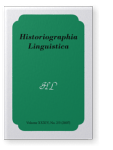Vol. 34:2/3 (2007) ► pp.213–256
Letters, sounds and things
Orthography, phonetics and metaphysics in Wilkins’s Essay (1668)
For a long time, and well beyond the publication of John Wilkins’s Essay Towards a Real Character (1668), a latent tension characterised the orthographic tradition. It was caused by two incompatible principles whose problematic relationship had never been addressed. One is the idea of the logical, chronological and semiotic primacy of speech over writing, or of sound over character, a principle which lives on in modern linguistics. The other is the doctrine of an abstract unity of sound/potestas and character/figura in the letter/littera, an axiom that appears to have been abandoned only with the emancipation of modern phonetics from its former orthographic frame of reference. With the advent of the real-character movement in the 17th century, a way was suddenly opened up for the problematic issue to be discussed and resolved. Since a real, i.e., non-sound-related, character implied at least a non-priority of speech over writing — if not a priority of writing —, the first principle could be reformulated so as to be made consonant with the idea of an abstract littera. This paper tries to bring out Wilkins’s sophisticated discussion of the littera, his attempt to localise the abstract unity of sound and character in the configuration of the articulatory organs, as well as the utilisation of his littera concept for his design of a real character of sounds. In a parallel line of argument, it is claimed that Wilkins’s orthography, or doctrine of letters, forms the conceptual equivalent to his metaphysics, or science of things. More than that, the two disciplines are so interlocked that things and letters can be seen to converge in letter-things, or thing-letters.
